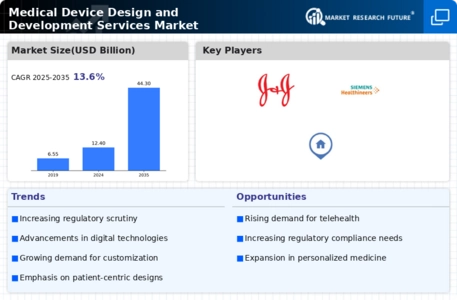Growing aging population is driving the market growth
Market CAGR for Medical Device Design and Development Services is being driven by the growing aging population. As the global population ages, there is an increased prevalence of age-related health issues and chronic conditions, such as cardiovascular diseases, diabetes, and osteoarthritis. This demographic shift creates a higher demand for innovative medical devices that cater to the specific needs of elderly patients, including mobility aids, remote monitoring devices, and assistive technologies. Medical device design and development services providers play a crucial role in addressing these needs by developing user-friendly, ergonomic, and technologically advanced devices tailored to the aging population.
Their expertise in designing devices that enhance quality of life, promote independence, and improve patient outcomes contributes to meeting the healthcare needs of an aging society.
The ever-increasing prevalence of chronic ailments stands as a formidable force propelling the trajectory of the Medical Device Design and Development Services Market. Chronic maladies, encompassing the likes of diabetes, cardiovascular afflictions, cancer, and respiratory disorders, wield a pervasive influence across global demographics, spurred by a convergence of factors including the advancing age demographics, sedentary lifestyle choices, and the pervasive embrace of dietary habits that veer towards the unhealthy end of the spectrum.
In this intricate landscape of healthcare challenges, the role of medical devices emerges as nothing short of pivotal, assuming multifaceted functions ranging from diagnostic prowess to the realms of continuous monitoring and personalized therapeutic interventions. Within this dynamic milieu, the onus squarely falls on the shoulders of design and development service providers, tasked with the formidable mandate of fashioning groundbreaking medical contrivances adept at navigating the labyrinthine intricacies of chronic ailments.
The essence of innovation pulsates at the core of their endeavors, a relentless pursuit of solutions that seamlessly integrate the imperatives of accuracy in diagnosis, perpetuity in monitoring, and the bespoke tailoring of therapeutic regimens to suit the idiosyncratic needs of each patient grappling with chronic afflictions. This endeavor, however, is no mere dalliance with convention; it represents a convergence of cutting-edge technologies and the fusion of interdisciplinary expertise, as these intrepid service providers strive to forge a path towards the vanguard of medical innovation.
Their creations, borne of this crucible of innovation, stand as bulwarks against the encroaching tide of chronic diseases, arming healthcare practitioners with tools capable of not merely detecting the faint whispers of pathology, but of orchestrating a symphony of preemptive interventions aimed at forestalling the advent of debilitating complications.
Early detection becomes more than a mere catchphrase; it evolves into a tangible reality, a beacon of hope illuminating the path towards effective management and the prophylactic mitigation of the ravages wrought by chronic ailments. In essence, the nexus between medical device design and the exigencies of chronic diseases underscores a symbiotic relationship wherein innovation serves as the currency facilitating the exchange between human ingenuity and the imperatives of comprehensive healthcare provision.
As the clamor for holistic solutions resonates ever more fervently across the healthcare landscape, the role of design and development services providers assumes a significance that transcends mere commercial imperatives, emerging as custodians of a vision wherein the promise of a healthier tomorrow beckons tantalizingly on the horizon.
Increasing regulatory requirements are driving the Medical Device Design and Development Services Market in several ways. Regulatory authorities, such as the FDA in the United States and the European Medicines Agency (EMA) in Europe, continue to implement stricter regulations to ensure the safety, efficacy, and quality of medical devices. Compliance with these regulations is essential for market approval and commercialization of medical devices. Design and development services providers play a critical role in navigating the complex regulatory landscape by offering expertise in regulatory affairs, quality management systems, and documentation.
They assist medical device companies in adhering to regulatory requirements throughout the product development lifecycle, from initial concept design to post-market surveillance. As regulatory scrutiny intensifies, the demand for specialized design and development services providers with regulatory expertise grows, driving market growth in the medical device sector. Thus, driving the Medical Device Design and Development Services market revenue.
For instance, Stryker introduced the Easy Fuse Dynamic Compression System, a foot and ankle staple system intended to streamline surgical procedures, offer robust dynamic-compression implants, and minimize waste in the operating room.
The ongoing evolution of healthcare technology appears to drive an increasing demand for specialized medical device design and development services, reflecting a broader trend towards personalized and efficient patient care solutions.
U.S. Food and Drug Administration (FDA)














